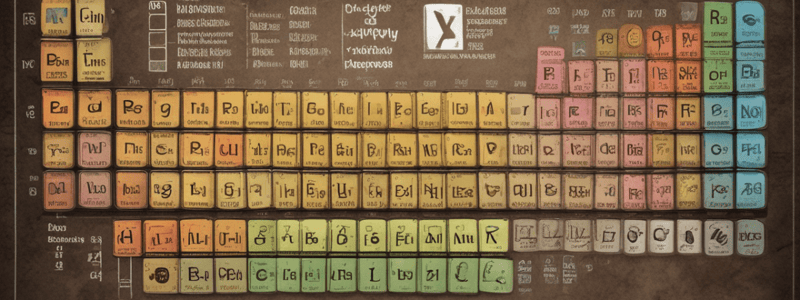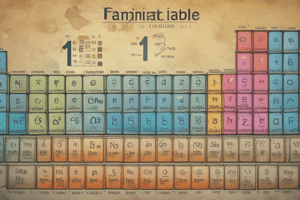Podcast
Questions and Answers
What was the primary basis of arrangement of elements in the periodic table according to Dmitri Mendeleev?
What was the primary basis of arrangement of elements in the periodic table according to Dmitri Mendeleev?
- Increasing atomic weight (correct)
- Similar chemical properties
- Electrolysis
- Increasing atomic number
Which scientist is credited with the discovery of the properties of elements in a triad?
Which scientist is credited with the discovery of the properties of elements in a triad?
- John Newlands
- Johann Dobereiner (correct)
- Henry Moseley
- Humphry Davy
What was the term used by John Newlands to describe the groups of elements with similar properties?
What was the term used by John Newlands to describe the groups of elements with similar properties?
- Groups
- Triads
- Periods
- Octaves (correct)
What was the innovation introduced by Henry Moseley in the arrangement of elements in the periodic table?
What was the innovation introduced by Henry Moseley in the arrangement of elements in the periodic table?
What was the significance of the gaps left by Dmitri Mendeleev in his periodic table?
What was the significance of the gaps left by Dmitri Mendeleev in his periodic table?
Which scientist used X-rays to determine the number of protons in the nucleus of an atom?
Which scientist used X-rays to determine the number of protons in the nucleus of an atom?
Which of the following scientists was the first to isolate potassium and sodium?
Which of the following scientists was the first to isolate potassium and sodium?
What was the underlying principle behind Johann Dobereiner's triads?
What was the underlying principle behind Johann Dobereiner's triads?
Why did Dmitri Mendeleev place Iodine and Tellurium out of order in his periodic table?
Why did Dmitri Mendeleev place Iodine and Tellurium out of order in his periodic table?
What was the significance of the eighth element in John Newlands' octaves?
What was the significance of the eighth element in John Newlands' octaves?
What was the main difference between the arrangement of elements by Dmitri Mendeleev and Henry Moseley?
What was the main difference between the arrangement of elements by Dmitri Mendeleev and Henry Moseley?
Which of the following scientists did not contribute to the development of the modern periodic table?
Which of the following scientists did not contribute to the development of the modern periodic table?
Flashcards
Mendeleev's Periodic Table Basis
Mendeleev's Periodic Table Basis
Arranging elements in order of increasing atomic weight formed the basis of Mendeleev's periodic table.
Dobereiner's Triads
Dobereiner's Triads
Johann Dobereiner observed that groups of three elements (triads) shared similar chemical properties.
Newlands' Octaves
Newlands' Octaves
John Newlands noticed that elements with similar properties appeared at regular intervals, like octaves in music.
Moseley's Atomic Number
Moseley's Atomic Number
Signup and view all the flashcards
Mendeleev's Gaps
Mendeleev's Gaps
Signup and view all the flashcards
Moseley's X-ray Discovery
Moseley's X-ray Discovery
Signup and view all the flashcards
Davy's Alkali Metals
Davy's Alkali Metals
Signup and view all the flashcards
Underlying Principle of Dobereiner's Triads
Underlying Principle of Dobereiner's Triads
Signup and view all the flashcards
Mendeleev's Order Adjustment
Mendeleev's Order Adjustment
Signup and view all the flashcards
Significance of the Eighth Element
Significance of the Eighth Element
Signup and view all the flashcards
Mendeleev vs. Moseley Arrangement
Mendeleev vs. Moseley Arrangement
Signup and view all the flashcards
Ancient Greeks and the Periodic Table
Ancient Greeks and the Periodic Table
Signup and view all the flashcards
Study Notes
Development of the Periodic Table
- Ancient Greeks believed in 4 elements: Earth, Air, Wind, Fire.
- Robert Boyle defined an element as a substance that cannot be split into simpler substances by chemical means.
Contributions of Key Scientists
- Humphry Davy used electrolysis to break down water into hydrogen and oxygen and isolated potassium and sodium.
- Johann Dobereiner discovered triads, where elements in a triad have similar chemical properties and the atomic weight of the middle element is halfway between the other two.
- John Newlands arranged elements in increasing atomic weights and found that the eighth element had properties similar to the first, calling these groups octaves.
Dmitri Mendeleev's Contributions
- Arranged elements in order of increasing atomic weight.
- Listed subgroups for elements like Cu & Ag whose properties didn't fit into the main group.
- Placed Iodine & Tellurium out of order of atomic weight.
- Left gaps for undiscovered elements and predicted their properties.
Henry Moseley's Contributions
- Arranged elements in order of increasing atomic number, not atomic weight.
- Used X-rays to determine the number of protons in the nucleus of an atom.
The Modern Periodic Table
- A list of elements arranged in increasing atomic number.
- Arranged into horizontal periods and vertical groups.
Studying That Suits You
Use AI to generate personalized quizzes and flashcards to suit your learning preferences.




